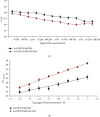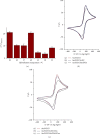Development of a Nanostructured Electrochemical Genosensor for the Detection of the K-ras Gene
- PMID: 36299712
- PMCID: PMC9592225
- DOI: 10.1155/2022/6575140
Development of a Nanostructured Electrochemical Genosensor for the Detection of the K-ras Gene
Abstract
In the scientific literature, it has been documented that electrochemical genosensors are novel analytical tools with proven clinical diagnostic potential for the identification of carcinogenic processes due to genetic and epigenetic alterations, as well as infectious diseases due to viruses or bacteria. In the present work, we describe the construction of an electrochemical genosensor for the identification of the k12p.1 mutation; it was based on use of Screen-Printed Gold Electrode (SPGE), Cyclic Voltammetry (CV), and Atomic Force Microscopy (AFM), for the monitoring the electron transfer trough the functionalized nanostructured surface and corresponding morphological changes. The sensitivity of the genosensor showed a linear response for the identification of the k12p.1 mutation of the K-ras gene in the concentration range of 10 fM to 1 μM with a detection limit of 7.96 fM in the presence of doxorubicin (Dox) as DNA intercalating agent and indicator of the hybridization reaction. Thus, the electrochemical genosensor developed could be useful for the identification of diseases related with the K-ras oncogene.
Copyright © 2022 Luis Fernando Garcia-Melo et al.
Conflict of interest statement
The authors declare that they have no conflicts of interest.
Figures




Similar articles
-
An electrochemical genosensor for Salmonella typhi on gold nanoparticles-mercaptosilane modified screen printed electrode.J Biotechnol. 2014 Oct 20;188:9-16. doi: 10.1016/j.jbiotec.2014.08.002. Epub 2014 Aug 10. J Biotechnol. 2014. PMID: 25116360
-
A simple electrochemical genosensor based on polythiophene acetic acid film for detection of Schistosoma mansoni.Biotechnol Prog. 2025 Jun 2:e70048. doi: 10.1002/btpr.70048. Online ahead of print. Biotechnol Prog. 2025. PMID: 40454539
-
Electrochemical genosensor for the detection of Alexandrium minutum dinoflagellates.Talanta. 2021 Jan 15;222:121416. doi: 10.1016/j.talanta.2020.121416. Epub 2020 Jul 22. Talanta. 2021. PMID: 33167194
-
A novel DNA based bioassay toward ultrasensitive detection of Brucella using gold nanoparticles supported histidine: A new platform for the assay of bacteria in the cultured and human biofluids with and without polymerase chain reactions (PCR).Int J Biol Macromol. 2018 Dec;120(Pt A):422-430. doi: 10.1016/j.ijbiomac.2018.08.092. Epub 2018 Aug 19. Int J Biol Macromol. 2018. PMID: 30134188
-
Genosensors as an alternative diagnostic sensing approaches for specific detection of virus species: A review of common techniques and outcomes.Trends Analyt Chem. 2022 Oct;155:116686. doi: 10.1016/j.trac.2022.116686. Epub 2022 May 19. Trends Analyt Chem. 2022. PMID: 35611316 Free PMC article. Review.
Cited by
-
Gold nanoparticles functionalised with vancomycin enhance antibacterial activity and inhibit Streptococcus pneumoniae adherence and invasion in alveolar cells.J Antibiot (Tokyo). 2025 Aug 15. doi: 10.1038/s41429-025-00856-1. Online ahead of print. J Antibiot (Tokyo). 2025. PMID: 40817314
References
-
- Sung H., Ferlay J., Siegel R. L., et al. Global cancer statistics 2020: GLOBOCAN estimates of incidence and mortality worldwide for 36 cancers in 185 countries. Cancer Journal for Clinicians . 2021;71:209–249. - PubMed
-
- Neumann J., Zeindl-Eberhart E., Kirchner T., Jung A. Frequency and type of KRAS mutations in routine diagnostic analysis of metastatic colorectal cancer. Pathology, Research & Practice . 2009;205:858–862. - PubMed
LinkOut - more resources
Full Text Sources
Miscellaneous

